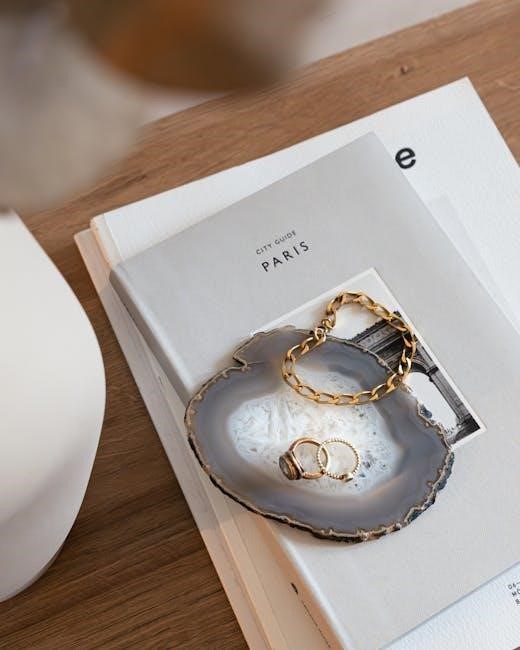O-Rings are versatile, circular seals made from elastomeric materials, widely used in mechanical applications to prevent leakage, valued for their reliability and cost-effectiveness across various industries.
1.1 What Are O-Rings?
O-Rings are circular, doughnut-shaped seals made from elastomeric materials like nitrile rubber, silicone, or fluorocarbon. They are designed to seal gaps between two surfaces, preventing the passage of liquids or gases. Their simplicity and effectiveness make them a cornerstone in various industries, from automotive to aerospace. O-Rings function by deforming under compression to create a tight barrier, ensuring leak-proof connections in both static and dynamic applications. Their versatility, durability, and ease of installation have solidified their role as a critical component in modern engineering.
1.2 Importance of O-Rings in Sealing Applications
O-Rings are indispensable in sealing applications due to their ability to prevent leakage of fluids and gases in both static and dynamic environments. Their reliability, cost-effectiveness, and versatility make them a critical component across industries like automotive, aerospace, and industrial manufacturing. By ensuring tight seals, O-Rings protect equipment from contamination, maintain performance, and prevent costly downtime. Their adaptability to various pressures, temperatures, and chemical exposures underscores their essential role in modern engineering and technology.

Materials Used for O-Rings
O-Rings are typically made from elastomers like nitrile, silicone, and Viton, each offering unique properties for different applications. Material selection is crucial for optimal sealing performance.

2.1 Common Elastomers and Their Properties
Nitrile (NBR) is widely used for its excellent resistance to oils and fuels, making it ideal for automotive applications. Silicone (VMQ) offers superior temperature resistance, suitable for high-heat environments. Fluorocarbon (Viton) excels in chemical resistance, often used in harsh industrial settings. Ethylene Propylene Diene Monomer (EPDM) is durable against water and steam, commonly applied in plumbing systems. Each elastomer has unique properties, making them suitable for specific sealing requirements, ensuring optimal performance in diverse operating conditions.

2.2 Chemical Compatibility and Material Selection
Material selection for O-rings hinges on chemical compatibility with the operating environment. Nitrile (NBR) resists oils and fuels, while Viton excels in harsh chemicals. Silicone (VMQ) is ideal for extreme temperatures. EPDM is suitable for water and steam. Understanding the chemical environment ensures optimal performance. Always consult compatibility charts to match materials with specific chemicals. Proper selection prevents degradation and ensures long-term sealing efficiency. This step is critical for reliability in industrial and hydraulic systems. Material choice directly impacts O-ring lifespan and sealing integrity.
O-Ring Dimensions and Standards
O-Ring dimensions are standardized to ensure consistent performance. Cross-sections and inner diameters are precisely specified to fit gland plates, guaranteeing reliable sealing in various applications and industries.
3.1 Standard Sizes and Tolerances
O-Ring standard sizes are essential for compatibility and interchangeability. Cross-sections typically range from 0.04″ to 0.25″, with inner diameters varying widely. Tolerances ensure proper fit and sealing performance. Close dimensional control prevents over-compression or insufficient sealing. These standards guide selection, ensuring reliability across applications, reducing leakage risks, and enhancing durability. Adhering to these specifications is crucial for optimal performance in various environments and ensures the O-ring functions as intended.
3.2 Understanding O-Ring Cross-Sections and Inner Diameters
O-Ring cross-sections are critical for determining sealing performance. Common cross-sections range from 0.04″ to 0.25″, with smaller sizes used in low-pressure applications and larger sizes for higher pressures. Inner diameters must match the gland plate dimensions precisely to ensure proper compression and sealing. A correct balance between cross-section and inner diameter ensures optimal sealing without excessive wear. Proper sizing prevents leakage and extends service life, making it vital for reliable operation in various mechanical systems and applications.

Design Considerations for O-Rings
O-Ring design involves balancing gland plate dimensions, squeeze ratio, and material properties to ensure optimal sealing performance under various thermal and chemical conditions, enhancing reliability and durability.
4.1 Gland Plate Design and Surface Finish
The gland plate design is critical for proper O-Ring sealing performance. The surface finish of the gland plate should be smooth, typically between 10-20 µin Ra, to ensure proper sealing without excessive wear. Sharp edges or rough surfaces can cause O-Ring damage. Proper dimensional tolerances are essential to maintain consistent compression and prevent extrusion. The gland plate material hardness should be sufficient to resist deformation. Improper gland plate design can lead to leakage or premature O-Ring failure, emphasizing the need for precise engineering and quality control.
4.2 Squeeze Ratio and Compression
The squeeze ratio, defined as the difference between the gland plate width and the O-Ring’s inner diameter, is crucial for proper sealing. A typical squeeze ratio ranges from 15% to 25%, ensuring adequate compression without excessive deformation. Proper compression ensures the O-Ring fills the gland plate evenly, creating a reliable seal. Excessive squeeze can lead to premature wear or extrusion, while insufficient compression may result in leakage. The ideal compression balances sealing performance and O-Ring longevity, depending on the application’s thermal and mechanical demands.

4.3 Thermal and Chemical Environment
O-Rings must withstand both thermal and chemical stresses in their operating environments. Material selection is critical to ensure compatibility with fluids and resistance to degradation. High temperatures can affect elasticity and sealing performance, while chemicals may cause swelling or hardening. Using chemical compatibility charts helps identify suitable materials. Ignoring these factors can lead to premature failure. Proper consideration of thermal and chemical conditions ensures reliable sealing and extends O-Ring service life.
Sealing Principles
O-Rings create a seal through compression between two surfaces, relying on material elasticity to fill gaps and prevent leakage, ensuring effective sealing in various applications.
5.1 Types of Seals: Static vs. Dynamic
Static seals are used in applications where there is no relative motion between components, such as flanges or covers, while dynamic seals involve moving parts, like pistons or cylinders. Static seals rely on compression to prevent leakage, while dynamic seals must account for friction and wear. Understanding the difference is crucial for selecting the right O-ring design, as dynamic applications require materials that can withstand movement without compromising sealing integrity over time.

5.2 Mechanisms of Sealing: Compression and Deformation
O-rings seal through compression and deformation, where the elastomeric material is compressed between two surfaces, creating a tight barrier against leakage. Compression ensures initial sealing, while deformation allows the O-ring to conform to surface irregularities, enhancing the seal. The material’s resilience enables it to rebound after deformation, maintaining sealing integrity. This dual mechanism is critical for both static and dynamic applications, ensuring reliable performance under varying conditions and preventing fluid or gas leakage effectively.
Selecting the Right O-Ring
Selecting the right O-ring involves understanding the application’s requirements, including temperature, pressure, and chemical exposure, to ensure the chosen material and size meet performance needs effectively.
6.1 Factors Influencing O-Ring Performance
The performance of an O-ring is influenced by several factors, including temperature, pressure, chemical compatibility, and mechanical stress. Temperature affects the elastomer’s elasticity and durability, while pressure impacts the sealing capability. Chemical compatibility is crucial to prevent degradation, and mechanical stress from dynamic applications can lead to wear. Additionally, the surface finish of the gland plate and the squeeze ratio play significant roles in ensuring proper sealing and preventing extrusion or compression issues. Understanding these factors is essential for optimal performance in any application. Proper material selection and dimensioning are also critical to ensure the O-ring functions effectively under specific conditions, making it necessary to consider all these elements when choosing the right O-ring for a given task.
6.2 Application-Specific O-Ring Types
O-rings are available in various types tailored to specific applications, ensuring optimal performance in diverse operating conditions. Standard O-rings are commonly used for general sealing needs, while custom designs cater to unique requirements. Specialty types include oil-resistant, heat-resistant, and chemically inert options. For instance, Viton O-rings are ideal for high-temperature and chemical exposure, whereas silicone O-rings excel in extreme temperature fluctuations. Application-specific designs also include anti-extrusion rings for high-pressure systems and low-temperature seals for cryogenic environments. Selecting the right type ensures reliability and longevity in hydraulic, pneumatic, and industrial applications.

Installation and Handling Best Practices
Proper installation involves clean, dry surfaces and avoiding stretching or twisting. Use tools to prevent damage. Lubricate sparingly and ensure correct alignment. Handle with care to prevent nicks or compression.
7.1 Proper Installation Techniques
Ensure surfaces are clean and dry before installation. Use recommended tools to avoid scratching or damaging the O-ring. Avoid stretching or twisting during insertion. Apply a small amount of compatible lubricant to ease placement without over-lubricating. Align the O-ring correctly with the gland plate, ensuring it seats properly. Avoid using sharp or abrasive tools that could nick or compress the O-ring. Proper installation prevents leakage and ensures optimal sealing performance and longevity of the O-ring.
7.2 Avoiding Damage During Handling

Handle O-rings with clean, dry gloves to prevent oils and dirt from compromising their surface. Avoid touching the O-ring with bare hands, as skin oils can degrade the material. Store O-rings in their original packaging to protect from dust and contamination. Do not expose them to direct sunlight or extreme temperatures. Never stretch or pull O-rings excessively, as this can cause permanent deformation. Damaged or deformed O-rings should be discarded to ensure reliable sealing performance and system integrity.

Testing and Quality Control
Testing ensures O-rings meet performance standards, while quality control verifies material integrity and manufacturing precision, ensuring reliability and durability in various applications and environments.
8.1 Methods for Testing O-Ring Performance
O-Ring performance is evaluated through various tests to ensure reliability and durability. Leakage tests assess sealing integrity under pressure, while compression-set tests measure deformation recovery. Material property tests, such as tensile strength and Shore hardness, verify elastomer quality. Additionally, thermal and chemical exposure tests simulate real-world conditions to ensure the O-Ring maintains its sealing properties in extreme environments. These methods collectively ensure the O-Ring meets application-specific requirements and industry standards for consistent performance.
8.2 Quality Control Measures
Quality control is crucial in ensuring O-Rings meet stringent performance and durability standards. Rigorous inspections include dimensional tolerances, material property verification, and visual checks for defects. Manufacturers employ advanced testing equipment to validate specifications, while process controls ensure consistency during production. Certification to industry standards like ISO or ASTM further guarantees reliability. Proper packaging, labeling, and traceability are also essential to maintain quality and prevent counterfeit products, ensuring every O-Ring delivers optimal sealing performance in its intended application.
